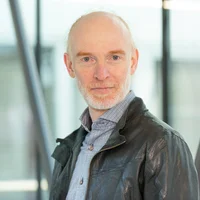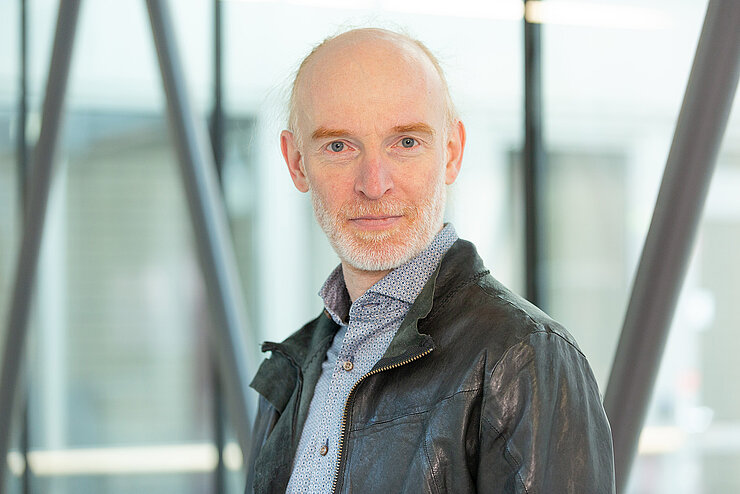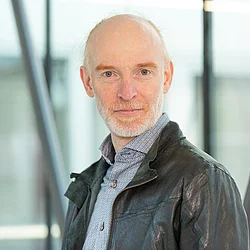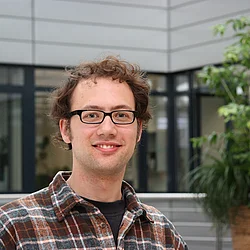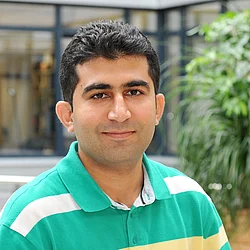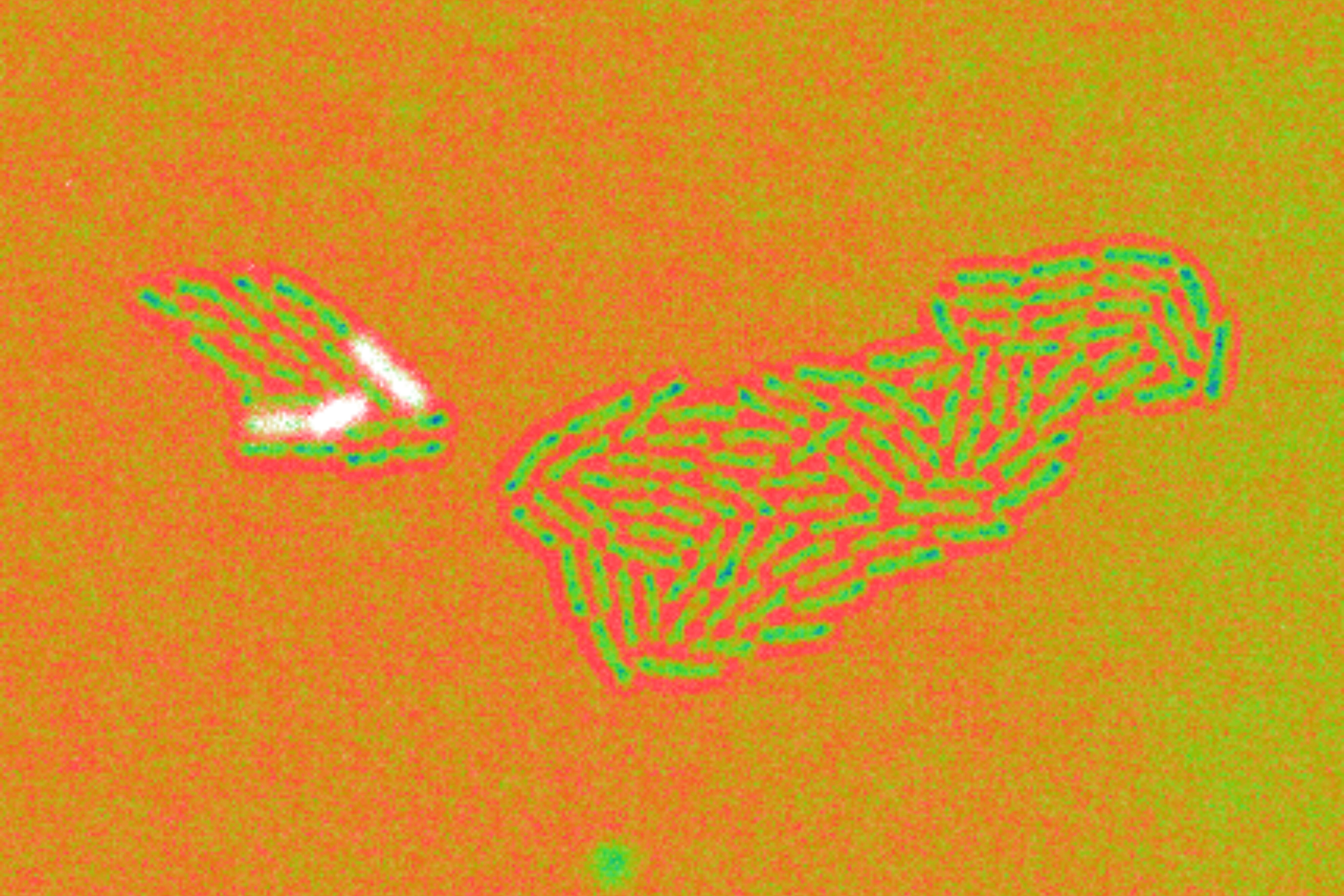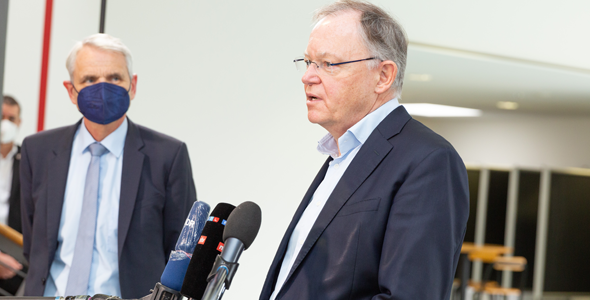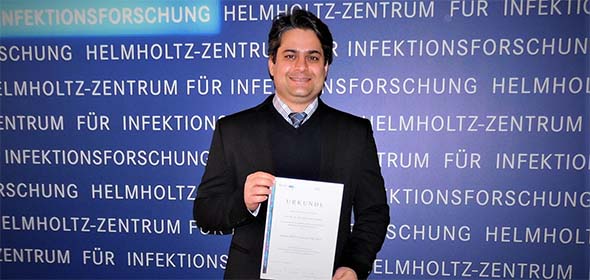Author count: 10
Vatareck E., Rick T., Gomez N.O., Bandyopadhyay A., Kramer J., Strunin D., Erdmann J., Hartmann O., ... , Alpers K., Boedeker C.
(2025)
Epigenetic cellular memory in Pseudomonas aeruginosa generates phenotypic variation in response to host environments
Proc Natl Acad Sci U S A,
122
(27)
Author count: 8
Schmid N., Bicker J., Hofmann A.F., Wallrafen-Sam K., Kerkmann D., Wieser A., ... , Kühn M.J., Hasenauer J.
(2025)
Integrative modeling of the spread of serious infectious diseases and corresponding wastewater dynamics
Epidemics,
51
(June 2025)
Author count: 10
Kerkmann D., Korf S., Nguyen K., Abele D., Schengen A., Gerstein C., Göbbert J.H., Basermann A., ... , Kühn M.J., Meyer-Hermann M.
(2025)
Agent-based modeling for realistic reproduction of human mobility and contact behavior to evaluate test and isolation strategies in epidemic infectious disease spread
Computers in Biology and Medicine,
193
(July 2025)
Author count: 23
Callemeyn J., Nava-Sedeno J.M., Anglicheau D., Beadle J., Bräsen J.H., Clahsen-van Groningen M.C., Cristoferi I., Loor H., Deutsch A., Essig M., Gwinner W., Halloran P.F., Hesselink D.A., Koshy P., Kuypers D., Lerut E., Marquet P., Minnee R.C., Roufosse C., Sprangers B., van Craenenbroeck A.H., ... , Hatzikirou H., Naesens M.
(2025)
Identification and Cross-Platform Validation of Sparse Molecular Classifiers for Antibody-mediated and T-Cell-Mediated Rejection After Kidney Transplantation
Kidney International Reports
Author count: 14
Pae J., Schwan N., Ottino-Loffler B., DeWitt W.S., Garg A., Bortolatto J., Vora A.A., Shen J.J., Hobbs A., Castro T.B.R., Mesin L., Matsen F.A., ... , Meyer-Hermann M., Victora G.D.
(2025)
Transient silencing of hypermutation preserves B cell affinity during clonal bursting
Nature
Author count: 4
Bicker J., Schmieding R., Meyer-Hermann M., K++hn M.J.
(2025)
Hybrid metapopulation agent-based epidemiological models for efficient insight on the individual scale: A contribution to green computing
Infectious Disease Modelling,
10
(2)
Author count: 7
Kunze-Schumacher H., Verheyden N.A., Grewers Z., Meyer-Hermann M., Greiff V., ... , Robert P.A., Krueger A.
(2025)
High-resolution mapping of cell cycle dynamics during steady-state T cell development and regeneration in vivo
Cell Rep.,
44
(1)
Author count: 8
Zunker H., Schmieding R., Kerkmann D., Schengen A., Diexer S., Mikolajczyk R., ... , Meyer-Hermann M., K++hn M.J.
(2024)
Novel travel time aware metapopulation models and multi-layer waning immunity for late-phase epidemic and endemic scenarios
PLoS Comput.Biol.,
20
(12)
Author count: 1
Mondal S.
(2024)
Single cell genomics unleashed: exploring the landscape of endometriosis with machine learning, gene expression profiling, and therapeutic target discovery
(26)
Author count: 5
Berhe H.W., Gebremeskel A.A., Melese Z.T., Al-arydah M., Gebremichael A.A.
(2024)
Modeling and global stability analysis of COVID-19 dynamics with optimal control and cost-effectiveness analysis
Partial Differential Equations in Applied Mathematics,
11
(September 2024)
Author count: 8
Berhe H.W., Gebremeskel A.A., Atsbaha H.A., Kefela Y.Y., Asgedom A.A., Woldegerima W.A., ... , Osman S., Kabareh L.
(2024)
Modelling and stability analysis of the dynamics of measles with application to Ethiopian data
Heliyon,
10
(13)
Author count: 12
Memon S., Jadebeck J.F., Osthege M., Wendler A., Kerkmann D., Zunker H., Wiechert W., Nöh K., Göbbert J.H., Hagemeier B., ... , Riedel M., Kühn M.J.
(2024)
Automated Processing of Pipelines Managing Now- and Forecasting of Infectious Diseases
Author count: 10
Merino Tejero E., Mao Q., Lashgari D., Garcia-Valiente R., Robert P.A., Meyer-Hermann M., Rodriguez Martinez M., Guikema J.E.J., ... , Hoefsloot H.H.C., Van Kampen A.H.C.
(2024)
Multi-Scale Modeling Recapitulates the Effect of Genetic Alterations Associated With Diffuse Large B-Cell Lymphoma in the Germinal Center Dynamics
Front.Syst.Biol.,
2
(4 / April 2022)
Author count: 19
Lebedin M., Ratswohl C., Garg A., Schips M., Garcia C.V., Spatt L., Thibeault C., Obermayer B., Weiner J., Velasquez I.M., Gerhard C., Stubbemann P., Hanitsch L.G., Pischon T., Witzenrath M., Sander L.E., Kurth F., ... , Meyer-Hermann M., de la Rosa K.
(2024)
Soluble ACE2 correlates with severe COVID-19 and can impair antibody responses
iScience,
27
(3)
Author count: 3
Melese Z.T., Berhe H.W., Woldegerima W.A.
(2024)
On the exponential stability of a stochastic model for transmission dynamics of antimicrobial-resistant infections
Mathematical Methods in the Applied Sciences
Author count: 15
Betz P.K., Stoll J., Grappendorf V., Gilg J., Zeumer M., Klitz M., Spataro L., Klein A., Rothenhaeusler L., Bohnacker H., Kraemer H., Meyer-Hermann M., Somogyi S., ... , Gerndt A., Kuhn M.J.
(2023)
ESID: Exploring the Design and Development of a Visual Analytics Tool for Epidemiological Emergencies
Author count: 3
Robert P.A., Arulraj T., Meyer-Hermann M.
(2023)
Germinal centers are permissive to subdominant antibody responses
Frontiers in Immunology,
14
Author count: 15
Brockhaus E.K., Wolffram D., Stadler T., Osthege M., Mitra T., Littek J.M., Krymova E., Klesen A.J., Huisman J.S., Heyder S., Helleckes L.M., An Der Heiden M., Funk S., ... , Abbott S., Bracher J.
(2023)
Why are different estimates of the effective reproductive number so different? A case study on COVID-19 in Germany
PLoS Comput.Biol.,
19
(11)
Author count: 4
Schips M., Mitra T., Bandyopadhyay A., Meyer-Hermann M.
(2023)
Suppressive might of a few: T follicular regulatory cells impede auto-reactivity despite being outnumbered in the germinal centres
Front.Immunol.,
14
Author count: 5
Morisod K., Nguyen K., Grazioli V.S., Marti J., Bodenmann P.
(2023)
Understanding health equity through artificial intelligence The case of Agent-Based Modelling (ABM) [[Comprendre l'équité en santé grâce à l'intelligence artificielle. L'exemple de l'Agent-Based Modelling (ABM), Article in French]
Rev Med Suisse,
19
(834)
Author count: 23
Silva-Cayetano A., Fra-Bido S., Robert P.A., Innocentin S., Burton A.R., Watson E.M., Lee J.L., Webb L.M.C., Foster W.S., McKenzie R.C.J., Bignon A., Vanderleyden I., Alterauge D., Lemos J.P., Carr E.J., Hill D.L., Cinti I., Balabanian K., Baumjohann D., Espeli M., Meyer-Hermann M., ... , Denton A.E., Linterman M.A.
(2023)
Spatial dysregulation of T follicular helper cells impairs vaccine responses in aging
Nat.Immunol.
Author count: 5
Garg A.K., Mitra T., Schips M., Bandyopadhyay A., Meyer-Hermann M.
(2023)
Amount of antigen, T follicular helper cells and affinity of founder cells shape the diversity of germinal center B cells: A computational study
Front.Immunol.,
14
Author count: 20
Grootveld A.K., Kyaw W., Panova V., Lau A.W.Y., Ashwin E., Seuzaret G., Dhenni R., Bhattacharyya N.D., Khoo W.H., Biro M., Mitra T., Meyer-Hermann M., Bertolino P., Tanaka M., Hume D.A., Croucher P.I., Brink R., Nguyen A., ... , Bannard O., Phan T.G.
(2023)
Apoptotic cell fragments locally activate tingible body macrophages in the germinal center
Cell,
186
(6)
Author count: 17
García-Valiente R., Merino Tejero E., Stratigopoulou M., Balashova D., Jongejan A., Lashgari D., Pélissier A., Caniels T.G., Claireaux M.A.F., Musters A., van Gils M.J., Rodríguez Martínez M., de Vries N., Meyer-Hermann M., Guikema J.E.J., ... , Hoefsloot H., Van Kampen A.H.C.
(2023)
Understanding repertoire sequencing data through a multiscale computational model of the germinal center
npj Syst.Bio.Appl.,
9
(1)
Author count: 3
Khailaie S., Robert P.A., Meyer-Hermann M.
(2021)
An Agent-Based Model of T Helper Cell Fate Decisions in the Thymus
(2)
Author count: 35
Mlynarczyk C., Teater M., Pae J., Chin C.R., Wang L., Arulraj T., Barisic D., Papin A., Hoehn K.B., Kots E., Ersching J., Bandyopadhyay A., Barin E., Poh H.X., Evans C.M., Chadburn A., Chen Z., Shen H., Isles H.M., Pelzer B., Tsialta I., Doane A.S., Geng H., Rehman M.H., Melnick J., Morgan W., Nguyen D.T.T., Elemento O., Kharas M.G., Jaffrey S.R., Scott D.W., Khelashvili G., Meyer-Hermann M., ... , Victora G.D., Melnick A.
(2023)
BTG1 mutation yields supercompetitive B cells primed for malignant transformation
Sci.,
379
(6629)
Author count: 6
Gurwicz N., Stoler-Barak L., Schwan N., Bandyopadhyay A., Meyer-Hermann M., Shulman Z.
(2023)
Tingible body macrophages arise from lymph node-resident precursors and uptake B cells by dendrites
J Exp Med,
220
(4)
Author count: 6
AL-Ahdal T., Coker D., Awad H., Reda A., Zuratinsy P., Khailaie S.
(2022)
Improving Public Health Policy by Comparing the Public Response during the Start of COVID-19 and Monkeypox on Twitter in Germany: A Mixed Methods Study
Vaccines,
10
(12)
Author count: 3
Arulraj T., Binder S.C., Meyer-Hermann M.
(2022)
Antibody Mediated Intercommunication of Germinal Centers
Cells,
11
(22)
Author count: 8
Papaxenopoulou L.A., Zhao G., Khailaie S., Katsoulis-Dimitriou K., Schmitz I., Medina E., ... , Hatzikirou H., Meyer-Hermann M.
(2022)
In silico predicted therapy against chronic Staphylococcus aureus infection leads to bacterial clearance in vivo
iScience,
25
(12)
Author count: 3
Arulraj T., Binder S.C., Meyer-Hermann M.
(2022)
Investigating the Mechanism of Germinal Center Shutdown
Front.Immunol.,
13
Author count: 6
Bandyopadhyay A., Schips M., Mitra T., Khailaie S., Binder S.C., Meyer-Hermann M.
(2022)
Testing and isolation to prevent overloaded healthcare facilities and reduce death rates in the SARS-CoV-2 pandemic in Italy
Commun.Med.(Lond),
2
Author count: 16
Arshad H., Siokis A., Franke R., Habib A., Alfonso J.C.L., Poliakova Y., Lücke E., Michaelis K., Brönstrup M., Meyer-Hermann M., Bilitewski U., Vila J., Abel L., Illig T., ... , Schreiber J., Pessler F.
(2022)
Reprogramming of Amino Acid Metabolism Differs between Community-Acquired Pneumonia and Infection-Associated Exacerbation of Chronic Obstructive Pulmonary Disease
Cells,
11
(15)
Author count: 3
Zhao G., Straub R.H., Meyer-Hermann M.
(2022)
The transition between acute and chronic infections in light of energy control: a mathematical model of energy flow in response to infection
J.R.Soc.Interface,
19
(191)
Author count: 6
Spiliotis K., Koutsoumaris C.C., Reppas A.I., Papaxenopoulou L.A., Starke J., Hatzikirou H.
(2022)
Optimal vaccine roll-out strategies including social distancing for pandemics
iScience.,
25
(7)
Author count: 7
Lashgari D., Merino Tejero E., Meyer-Hermann M., Claireaux M.A.F., van Gils M.J., ... , Hoefsloot H.C.J., Van Kampen A.H.C.
(2022)
From affinity selection to kinetic selection in Germinal Centre modelling
PLoS.Comput.Biol.,
18
(6)
Author count: 5
Mascheroni P., Savvopoulos S., Alfonso J.C.L., Meyer-Hermann M., Hatzikirou H.
(2021)
Improving personalized tumor growth predictions using a Bayesian combination of mechanistic modeling and machine learning
Commun.Med.(Lond),
1
Author count: 7
Koslow W., Kühn M.J., Binder S., Klitz M., Abele D., ... , Basermann A., Meyer-Hermann M.
(2022)
Appropriate relaxation of non-pharmaceutical interventions minimizes the risk of a resurgence in SARS-CoV-2 infections in spite of the Delta variant
PLoS.Comput.Biol.,
18
(5)
Author count: 7
Schlicker L., Zhao G., Dudek C.A., Boers H.M., Meyer-Hermann M., ... , Jacobs D.M., Hiller K.
(2022)
Systemic Lactate Acts as a Metabolic Buffer in Humans and Prevents Nutrient Overflow in the Postprandial Phase
Frontiers in Nutrition,
9
Author count: 12
Kühn M.J., Abele D., Binder S., Rack K., Klitz M., Kleinert J., Gilg J., Spataro L., Koslow W., Siggel M., ... , Meyer-Hermann M., Basermann A.
(2022)
Regional opening strategies with commuter testing and containment of new SARS-CoV-2 variants in Germany
BMC Infectious Diseases,
22
(1)
Author count: 12
Grass D.G., Alfonso J.C.L., Welsh E., Ahmed K.A., Teer J.K., Pilon-Thomas S., Harrison L.B., Cleveland J.L., Mulé J.J., Eschrich S.A., ... , Enderling H., Torres-Roca J.F.
(2022)
The Radiosensitivity Index (RSI) Gene Signature Identifies Distinct Tumor Immune Microenvironment Characteristics Associated with Susceptibility to Radiotherapy
Int.J Radiat.Oncol.Biol.Phys.
Author count: 12
Dorn F., Khailaie S., Stoeckli M., Binder S.C., Mitra T., Lange B., Lautenbacher S., Peichl A., Vanella P., Wollmershäuser T., ... , Fuest C., Meyer-Hermann M.
(2022)
The common interests of health protection and the economy: evidence from scenario calculations of COVID-19 containment policies
Eur.J.Health Econ.
Author count: 5
Long Z., Phillips B., Radtke D., Meyer-Hermann M., Bannard O.
(2022)
Competition for refueling rather than cyclic reentry initiation evident in germinal centers
Sci Immunol,
7
(69)
Author count: 5
Garg A.K., Mittal S., Padmanabhan P., Desikan R., Dixit N.M.
(2021)
Increased B Cell Selection Stringency In Germinal Centers Can Explain Improved COVID-19 Vaccine Efficacies With Low Dose Prime or Delayed Boost
Front.Immunol.,
12
Author count: 3
Alipour A., Abedi M., Habibi M.
(2022)
Controlling salt crystallization in evaporating thin films of colloidal liquids
Colloids Surf.A Physicochem.Eng.Asp.,
636
Author count: 18
Knabl L., Mitra T., Kimpel J., Rössler A., Volland A., Walser A., Ulmer H., Pipperger L., Binder S.C., Riepler L., Bates K., Bandyopadhyay A., Schips M., Ranjan M., Falkensammer B., Borena W., ... , Meyer-Hermann M., Von Laer D.
(2021)
High SARS-CoV-2 seroprevalence in children and adults in the Austrian ski resort of Ischgl
Commun.Med.(London),
1
(1)
Author count: 8
Siokis A., Robert P.A., Demetriou P., Kvalvaag A., Valvo S., Mayya V., ... , Dustin M.L., Meyer-Hermann M.
(2021)
Characterization of mechanisms positioning costimulatory complexes in immune synapses
iScience.,
24
(10)
Author count: 12
Alfonso J.C.L., Grass G.D., Welsh E., Ahmed K.A., Teer J.K., Pilon-Thomas S., Harrison L.B., Cleveland J.L., Mule J.J., Eschrich S.A., ... , Torres-Roca J.F., Enderling H.
(2021)
Tumor-immune ecosystem dynamics define an individual Radiation Immune Score to predict pan-cancer radiocurability
Neoplasia,
23
(11)
Author count: 3
Robert P.A., Arulraj T., Meyer-Hermann M.
(2021)
Ymir: A 3D structural affinity model for multi-epitope vaccine simulations
iScience.,
24
(9)
Author count: 9
Merino Tejero E., Lashgari D., García-Valiente R., He J., Robert P.A., Meyer-Hermann M., Guikema J.E.J., ... , Hoefsloot H., Van Kampen A.H.C.
(2021)
Coupled Antigen and BLIMP1 Asymmetric Division With a Large Segregation Between Daughter Cells Recapitulates the Temporal Transition From Memory B Cells to Plasma Cells and a DZ-to-LZ Ratio in the Germinal Center
Front.Immunol.,
12
Author count: 1
Meyer-Hermann M.
(2021)
A molecular theory of germinal center B cell selection and division
Cell Rep.,
36
(8)
Author count: 3
Arulraj T., Binder S.C., Meyer-Hermann M.
(2021)
In Silico Analysis of the Longevity and Timeline of Individual Germinal Center Reactions in a Primary Immune Response
Cells,
10
(7)
Author count: 4
Arulraj T., Binder S.C., Robert P.A., Meyer-Hermann M.
(2021)
Germinal Centre Shutdown
Front Immunol.,
12
Author count: 4
Priesemann V., Meyer-Hermann M., Pigeot I., Schöbel A.
(2021)
Der Beitrag von epidemiologischen Modellen zur Beschreibung des Ausbruchsgeschehens der COVID-19-Pandemie [The contribution of epidemiological models to the description of the outbreak of the COVID-19 pandemic]
Bundesgesund.blatt.Gesund.forschung.Gesund.schutz.,
64
(9)
Author count: 20
Kühn M.J., Abele D., Mitra T., Koslow W., Abedi M., Rack K., Siggel M., Khailaie S., Klitz M., Binder S., Spataro L., Gilg J., Kleinert J., Häberle M., Plötzke L., Spinner C.D., Stecher M., Zhu X.X., ... , Basermann A., Meyer-Hermann M.
(2021)
Assessment of effective mitigation and prediction of the spread of SARS-CoV-2 in Germany using demographic information and spatial resolution
Math.Biosci.,
339
(September 2021)
Author count: 7
Tretter F., Wolkenhauer O., Meyer-Hermann M., Dietrich J.W., Green S., ... , Marcum J., Weckwerth W.
(2021)
The Quest for System-Theoretical Medicine in the COVID-19 Era
Front.Med.,
8
Author count: 8
Linden M., Dehning J., Mohr S.B., Mohring J., Meyer-Hermann M., Pigeot I., ... , Schöbel A., Priesemann V.
(2020)
Case numbers beyond contact tracing capacity are endangering the containment of COVID-19 / [Überschreitung der Kontaktnachverfolgungskapazität gefährdet die Eindämmung von COVID-19]
Dtsch.Arztebl.Inter.,
117
(46)
Author count: 7
Barua A., Syga S., Mascheroni P., Kavallaris N., Meyer-Hermann M., ... , Deutsch A., Hatzikirou H.
(2020)
Entropy-driven cell decision-making predicts 'fluid-to-solid' transition in multicellular systems
New J.Phys.,
22
(12)
Author count: 10
Dorn F., Khailaie S., Stöckli M., Binder S., Lange B., Peichl A., Vanella P., Wollmershäuser T., ... , Fuest C., Meyer-Hermann M.
(2020)
Das gemeinsame Interesse von Gesundheit und Wirtschaft: Eine Szenarienrechnung zur Eindämmung der Corona Pandemie
ifo Schnelldienst digital,
1/2020
(6)
Author count: 13
Merino Tejero E., Lashgari D., Garcia-Valiente R., Gao X., Crauste F., Robert P.A., Meyer-Hermann M., Martinez M., Rodriguez Martinez M., Van Ham S.M., Guikema J.E.J., ... , Hoefsloot H., Van Kampen A.H.C.
(2021)
Multiscale Modeling of Germinal Center Recapitulates the Temporal Transition From Memory B Cells to Plasma Cells Differentiation as Regulated by Antigen Affinity-Based Tfh Cell Help
Front Immunol.,
11
Author count: 3
Arulraj T., Binder S.C., Meyer-Hermann M.
(2021)
Rate of Immune Complex Cycling in Follicular Dendritic Cells Determines the Extent of Protecting Antigen Integrity and Availability to Germinal Center B Cells
J.Immunol.,
206
(7)
Author count: 9
Elfaki Y., Robert P.A., Binz C., Falk C.S., Bruder D., Prinz I., Floess S., ... , Meyer-Hermann M., Hühn J.
(2021)
Influenza A virus-induced thymus atrophy differentially affects dynamics of conventional and regulatory T cell development in mice
Eur.J.Immunol.
Author count: 22
Volk V., Theobald S.J., Danisch S., Khailaie S., Kalbarczyk M., Schneider A., Bialek-Waldmann J., Krönke N., Deng Y., Eiz-Vesper B., Dragon A.C., Von Kaisenberg C., Lienenklaus S., Bleich A., Keck J., Meyer-Hermann M., Klawonn F., Hammerschmidt W., Delecluse H.J., Münz C., ... , Feuerhake F., Stripecke R.
(2021)
PD-1 Blockade Aggravates Epstein-Barr Virus(+) Post-Transplant Lymphoproliferative Disorder in Humanized Mice Resulting in Central Nervous System Involvement and CD4(+) T Cell Dysregulations
Front Oncol.,
10
Author count: 9
Khailaie S., Mitra T., Bandyopadhyay A., Schips M., Mascheroni P., Vanella P., Lange B., ... , Binder S.C., Meyer-Hermann M.
(2021)
Development of the reproduction number from coronavirus SARS-CoV-2 case data in Germany and implications for political measures
BMC.Med.,
19
(1)
Author count: 11
Nakagawa R., Toboso-Navasa A., Schips M., Young G., Bhaw-Rosun L., Llorian-Sopena M., Chakravarty P., Sesay A.K., Kassiotis G., ... , Meyer-Hermann M., Calado D.P.
(2021)
Permissive selection followed by affinity-based proliferation of GC light zone B cells dictates cell fate and ensures clonal breadth
Proc.Natl.Acad.Sci.U.S.A,
118
(2)
Author count: 4
Barua A., Nava-Sedeno J.M., Meyer-Hermann M., Hatzikirou H.
(2020)
A least microenvironmental uncertainty principle (LEUP) as a generative model of collective cell migration mechanisms
Sci.Rep.,
10
(1)
Author count: 13
Pae J., Ersching J., Castro T.B.R., Schips M., Mesin L., Allon S.J., Ordovas-Montanes J., Mlynarczyk C., Melnick A., Efeyan A., Shalek A.K., ... , Meyer-Hermann M., Victora G.D.
(2021)
Cyclin D3 drives inertial cell cycling in dark zone germinal center B cells
J.Exp.Med.,
218
(4)
Author count: 4
Rastogi A., Robert P.A., Halle S., Meyer-Hermann M.
(2020)
Evaluation of CD8 T cell killing models with computer simulations of 2-photon imaging experiments
PLoS.Comput.Biol.,
16
(12)
Author count: 48
Demetriou P., Abu-Shah E., Valvo S., McCuaig S., Mayya V., Kvalvaag A., Starkey T., Korobchevskaya K., Lee L.Y.W., Friedrich M., Mann E., Kutuzov M.A., Morotti M., Wietek N., Rada H., Yusuf S., Afrose J., Siokis A., Allan P., Ambrose T., Arancibia C., Bailey A., Barnes E., Bird-Lieberman E., Bornschein J., Brain O., Braden B., Collier J., Cobbold J., Culver E., East J., Howarth L., Klenerman P., Leedham S., Palmer R., Pavlides M., Powrie F., Rodrigues A., Satsangi J., Simmons A., Sullivan P., Uhlig H., Walsh A., Meyer-Hermann M., Ahmed A.A., Depoil D., ... , Dustin M.L., Oxford IBD Cohort I
(2020)
Author Correction: A dynamic CD2-rich compartment at the outer edge of the immunological synapse boosts and integrates signals (Nature Immunology, (2020), 21, 10, (1232-1243), 10.1038/s41590-020-0770-x)
Nat.Immunol.,
22
(1)
Author count: 3
Khailaie S., Montaseri G., Meyer-Hermann M.
(2020)
An Adaptive Control Scheme for Interleukin-2 Therapy
iScience,
23
(11)
Author count: 11
Rizzuti I.F., Mascheroni P., Arcucci S., Ben-Mériem Z., Prunet A., Barentin C., Rivière C., Delanoe-Ayari H., Hatzikirou H., ... , Guillermet-Guibert J., Delarue M.
(2020)
Mechanical Control of Cell Proliferation Increases Resistance to Chemotherapeutic Agents
Phys.Rev.Lett.,
125
(12)
Author count: 48
Demetriou P., Abu-Shah E., Valvo S., McCuaig S., Mayya V., Kvalvaag A., Starkey T., Korobchevskaya K., Lee L.Y.W., Friedrich M., Mann E., Kutuzov M.A., Morotti M., Wietek N., Rada H., Yusuf S., Afrose J., Siokis A., Allan P., Ambrose T., Arancibia C., Bailey A., Barnes E., Bird-Lieberman E., Bornschein J., Brain O., Braden B., Collier J., Cobbold J., Culver E., East J., Howarth L., Klenerman P., Leedham S., Palmer R., Pavlides M., Powrie F., Rodrigues A., Satsangi J., Simmons A., Sullivan P., Uhlig H., Walsh A., Meyer-Hermann M., Ahmed A.A., Depoil D., ... , Dustin M.L., Oxford IBD Cohort I
(2020)
A dynamic CD2-rich compartment at the outer edge of the immunological synapse boosts and integrates signals
Nat.Immunol.,
21
(10)
Author count: 2
Berk L., Lopez Alfonso J.C.
(2020)
Diminishing Returns From Ultrahypofractionated Radiation Therapy for Prostate Cancer In Regard to Vogelius et al
Int.J.Radiat.Oncol.Biol.Phys.,
108
(3)
Author count: 5
Freudenhammer M., Voll R.E., Binder S.C., Keller B., Warnatz K.
(2020)
Naive- and Memory-like CD21(low) B Cell Subsets Share Core Phenotypic and Signaling Characteristics in Systemic Autoimmune Disorders
J.Immunol.,
205
(8)
Author count: 3
Siokis A., Robert P.A., Meyer-Hermann M.
(2020)
Agent-Based Modeling of T Cell Receptor Cooperativity
Int.J.Mol.Sci.,
21
(18)
Author count: 2
Riebisch A.K., Mühlen S.
(2020)
Attaching and effacing pathogens: the effector abc of immune subversion
Future.Microbiol.,
15
(10)
Author count: 5
Hoore M., Khailaie S., Montaseri G., Mitra T., Meyer-Hermann M.
(2020)
Mathematical Model Shows How Sleep May Affect Amyloid-b[beta] Fibrillization
Biophys.J.,
119
(4)
Author count: 23
Theobald S.J., Kreer C., Khailaie S., Bonifacius A., Eiz-Vesper B., Figueiredo C., MacH M., Backovic M., Ballmaier M., Koenig J., Olbrich H., Schneider A., Volk V., Danisch S., Gieselmann L., Ercanoglu M.S., Messerle M., Kaisenberg C.V., Witte T., Klawonn F., Meyer-Hermann M., ... , Klein F., Stripecke R.
(2020)
Repertoire characterization and validation of gB-specific human IgGs directly cloned from humanized mice vaccinated with dendritic cells and protected against HCMV
PLoS Pathog.,
16
(7)
Author count: 13
Reimer D., Meyer-Hermann M., Rakhymzhan A., Steinmetz T., Tripal P., Thomas J., Boettcher M., Mougiakakos D., Schulz S.R., Urbanczyk S., Hauser A.E., ... , Niesner R.A., Mielenz D.
(2020)
B Cell Speed and B-FDC Contacts in Germinal Centers Determine Plasma Cell Output via Swiprosin-1/EFhd2
Cell Rep.,
32
(6)
Author count: 5
Nava-Sedeno J.M., Voß-Böhme A., Hatzikirou H., Deutsch A., Peruani F.
(2020)
Modelling collective cell motion: are on- and off-lattice models equivalent?
Philos.Trans.R.Soc.Lond., B, Biol.Sci.,
375
(1807)
Author count: 3
Mascheroni P., Meyer-Hermann M., Hatzikirou H.
(2020)
Investigating the Physical Effects in Bacterial Therapies for Avascular Tumors
Front.Microbiol.,
11
Author count: 4
Xenos M.A., Petropoulou E.N., Siokis A., Mahabaleshwar U.S.
(2020)
Solving the nonlinear boundary layer flow equations with pressure gradient and radiation
Symmetry,
12
(5)
Author count: 3
Mascheroni P., Grillo A., Boso D.P.
(2020)
Poro-mechanical analysis of a biomimetic scaffold for osteochondral defects
(60)
Author count: 3
Goldberg A., Rastogi A., Rosenberg N.A.
(2020)
Assortative mating by population of origin in a mechanistic model of admixture
Theor.Popul.Biol.,
134
(August)
Author count: 8
Schaadt N.S., Schönmeyer R., Forestier G., Brieu N., Braubach P., Nekolla K., ... , Meyer-Hermann M., Feuerhake F.
(2020)
Graph-based description of tertiary lymphoid organs at single-cell level
PLoS.Comput.Biol.,
16
(2)
Author count: 5
Alfonso J.C.L., Papaxenopoulou L.A., Mascheroni P., Meyer-Hermann M., Hatzikirou H.
(2020)
On the Immunological Consequences of Conventionally Fractionated Radiotherapy
iScience,
23
(3)
Author count: 1
Penta R.
(2019)
Porosity and Diffusion in Biological Tissues. Recent Advances and Further Perspectives
Solid Mechanics and its Applications
(11)
Author count: 4
Montaseri G., Alfonso J.C.L., Hatzikirou H., Meyer-Hermann M.
(2020)
A minimal modeling framework of radiation and immune system synergy to assist radiotherapy planning
J.Theor.Biol.,
486
(February)
Author count: 22
Arshad H., Alfonso J.C.L., Franke R., Michaelis K., Araujo L., Habib A., Zboromyrska Y., Lucke E., Strungaru E., Akmatov M.K., Hatzikirou H., Meyer-Hermann M., Petersmann A., Nauck M., Brönstrup M., Bilitewski U., Abel L., Sievers J., Vila J., Illig T., ... , Schreiber J., Pessler F.
(2019)
Decreased plasma phospholipid concentrations and increased acid sphingomyelinase activity are accurate biomarkers for community-acquired pneumonia
J.Transl.Med.,
17
(1)
Author count: 1
Meyer-Hermann M.
(2019)
Injection of Antibodies against Immunodominant Epitopes Tunes Germinal Centers to Generate Broadly Neutralizing Antibodies
Cell Reports,
29
(5)
Author count: 4
Arulraj T., Binder S.C., Robert P.A., Meyer-Hermann M.
(2019)
Synchronous germinal center onset impacts the efficiency of antibody responses
Front.Immunol.,
10
Author count: 20
Roco J.A., Mesin L., Binder S.C., Nefzger C., Gonzalez-Figueroa P., Canete P.F., Ellyard J., Shen Q., Robert P.A., Cappello J., Vohra H., Zhang Y., Nowosad C.R., Schiepers A., Corcoran L.M., Toellner K.M., Polo J.M., Meyer-Hermann M., ... , Victora G.D., Vinuesa C.G.
(2019)
Class-Switch Recombination Occurs Infrequently in Germinal Centers
Immunity.,
51
(2)
Author count: 5
Enderling H., Alfonso J.C.L., Moros E., Caudell J.J., Harrison L.B.
(2019)
Integrating Mathematical Modeling into the Roadmap for Personalized Adaptive Radiation Therapy
Trends Cancer,
5
(8)
Author count: 19
Canete P.F., Sweet R.A., Gonzalez-Figueroa P., Papa I., Ohkura N., Bolton H., Roco J.A., Cuenca M., Bassett K.J., Sayin I., Barry E., Lopez A., Canaday D.H., Meyer-Hermann M., Doglioni C., Fazekas de St Groth B., Sakaguchi S., ... , Cook M.C., Vinuesa C.G.
(2019)
Regulatory roles of IL-10-producing human follicular T cells
J.Exp.Med.,
216
(8)
Author count: 6
Mascheroni P., Lopez Alfonso J.C., Kalli M., Stylianopoulos T., Meyer-Hermann M., Hatzikirou H.
(2019)
On the Impact of Chemo-Mechanically Induced Phenotypic Transitions in Gliomas
Cancers.(Basel),
11
(5)
Author count: 2
Alfonso J.C.L., Berk L.
(2019)
Modeling the effect of intratumoral heterogeneity of radiosensitivity on tumor response over the course of fractionated radiation therapy
Radiat.Oncol.,
14
(1)
Author count: 9
Schlicker L., Boers H.M., Dudek C.A., Zhao G., Barua A., Trezzi J.P., Meyer-Hermann M., ... , Jacobs D.M., Hiller K.
(2019)
Postprandial Metabolic Effects of Fiber Mixes Revealed by in vivo Stable Isotope Labeling in Humans
Metabolites.,
9
(5)
Author count: 10
Lopez Alfonso J.C., Poleszczuk J., Walker R., Kim S., Pilon-Thomas S., Conejo-Garcia J.J., Soliman H., Czerniecki B., ... , Harrison L.B., Enderling H.
(2019)
Immunologic Consequences of Sequencing Cancer Radiotherapy and Surgery
JCO.Clin.Cancer Inform,
3
Author count: 23
Theobald S.J., Khailaie S., Meyer-Hermann M., Volk V., Olbrich H., Danisch S., Gerasch L., Schneider A., Sinzger C., Schaudien D., Lienenklaus S., Riese P., Guzmán C.A., Figueiredo C., Von Kaisenberg C., Spineli L.M., Glaesener S., Meyer-Bahlburg A., Ganser A., Schmitt M., MacH M., ... , Messerle M., Stripecke R.
(2018)
Signatures of T and B cell development, functional responses and PD-1 upregulation after HCMV latent infections and reactivations in Nod.Rag.Gamma mice humanized with cord blood CD34+cells
Front.Immunol.,
9
(NOV)
Author count: 4
Meyer-Hermann M., Binder S.C., Mesin L., Victora G.D.
(2018)
Computer Simulation of Multi-Color Brainbow Staining and Clonal Evolution of B Cells in Germinal Centers
Front Immunol,
9
(September)
Author count: 9
Khailaie S., Rowshanravan B., Robert P.A., Waters E., Halliday N., Badillo Herrera J.D., Walker L.S.K., ... , Sansom D.M., Meyer-Hermann M.
(2018)
Characterization of CTLA4 Trafficking and Implications for Its Function
Biophys.J.,
115
(7)
Author count: 1
Meyer-Hermann M.
(2018)
Estimation of the cancer risk induced by therapies targeting stem cell replication and treatment recommendations
Sci.Rep.,
8
(1)
Author count: 5
Siokis A., Robert P.A., Demetriou P., Dustin M.L., Meyer-Hermann M.
(2018)
F-Actin-Driven CD28-CD80 Localization in the Immune Synapse
Cell Rep.,
24
(5)
Author count: 4
Montaseri G., Boianelli A., Hernandez-Vargas E.A., Meyer-Hermann M.
(2018)
PK/PD-based adaptive tailoring of oseltamivir doses to treat within-host influenza viral infections
Prog.Biophys.Mol.Biol.
Author count: 1
Hatzikirou H.
(2018)
Statistical mechanics of cell decision-making: The cell migration force distribution
Journal of the Mechanical Behavior of Materials,
27
(1-2)
Author count: 10
Lopez Alfonso J.C., Parsai S., Joshi N., Godley A., Shah C., Koyfman S.A., Caudell J.J., Fuller C.D., ... , Enderling H., Scott J.G.
(2018)
Temporally feathered intensity modulated radiation therapy: a planning technique to reduce normal tissue toxicity
Med.Phys.,
45
(7)
Author count: 3
Robert P.A., Marschall A.L., Meyer-Hermann M.
(2018)
Induction of broadly neutralizing antibodies in Germinal Centre simulations
Curr.Opin.Biotechnol.,
51
(June)
Author count: 4
Nava-Sedeno J.M., Hatzikirou H., Klages R., Deutsch A.
(2017)
Cellular automaton models for time-correlated random walks: Derivation and analysis
Sci.Rep.,
7
(1)
Author count: 16
Volk V., Reppas A.I., Robert P.A., Spineli L.M., Sundarasetty B.S., Theobald S.J., Schneider A., Gerasch L., Roth C.D., Kl÷ss S., Koehl U., Von Kaisenberg C., Figueiredo C., Hatzikirou H., ... , Meyer-Hermann M., Stripecke R.
(2017)
Multidimensional analysis integrating human t-cell signatures in lymphatic tissues with sex of humanized mice for prediction of responses after dendritic cell immunization
Front.Immunol.,
8
(DEC)
Author count: 8
Alfonso J.C.L., Talkenberger K., Seifert M., Klink B., Hawkins-Daarud A., Swanson K.R., ... , Hatzikirou H., Deutsch A.
(2017)
The biology and mathematical modelling of glioma invasion: a review
J.R.Soc.Interface,
14
(136)
Author count: 4
Zhao G., Wirth D., Schmitz I., Meyer-Hermann M.
(2017)
A mathematical model of the impact of insulin secretion dynamics on selective hepatic insulin resistance
Nat.Commun.,
8
(1)
Author count: 4
Nava-Sedeno J.M., Hatzikirou H., Peruani F., Deutsch A.
(2017)
Extracting cellular automaton rules from physical Langevin equation models for single and collective cell migration
J.Math.Biol.,
75
(5)
Author count: 16
Papa I., Saliba D., Ponzoni M., Bustamante S., Canete P.F., Gonzalez-Figueroa P., McNamara H.A., Valvo S., Grimbaldeston M., Sweet R.A., Vohra H., Cockburn I.A., Meyer-Hermann M., Dustin M.L., ... , Doglioni C., Vinuesa C.G.
(2017)
TFH-derived dopamine accelerates productive synapses in germinal centres
Nature,
547
(7663)
Author count: 4
Robert P.A., Rastogi A., Binder S.C., Meyer-Hermann M.
(2017)
How to Simulate a Germinal Center
Methods Mol.Biol.,
1623
Author count: 11
Schaadt N.S., Alfonso J.C.L., Schonmeyer R., Grote A., Forestier G., Wemmert C., Kronke N., Stoeckelhuber M., Kreipe H.H., ... , Hatzikirou H., Feuerhake F.
(2017)
Image analysis of immune cell patterns in the human mammary gland during the menstrual cycle refines lymphocytic lobulitis
Breast Cancer Res.Treat.,
164
(2)
Author count: 5
Hatzikirou H., Alfonso J.C.L., Leschner S., Weiss S., Meyer-Hermann M.
(2017)
Therapeutic potential of bacteria against solid tumors
Cancer Res.,
77
(7)
Author count: 4
Torres-Cerna C.E., Alanis A.Y., Poblete-Castro I., Hernandez-Vargas E.A.
(2017)
Batch cultivation model for biopolymer production
Chem Biochem Eng Q,
31
(1)
Author count: 3
Siokis A., Robert P.A., Meyer-Hermann M.
(2017)
Mathematical Modeling of Synaptic Patterns
Methods Mol.Biol.,
1584
(12)
Author count: 2
Binder S.C., Meyer-Hermann M.
(2016)
Implications of intravital imaging of murine germinal centers on the control of B cell selection and division
Front.Immunol.,
7
(DEC)
Author count: 7
Duvigneau S., Sharma-Chawla N., Boianelli A., Stegemann-Koniszewski S., Nguyen V.K., ... , Bruder D., Hernandez-Vargas E.A.
(2016)
Hierarchical effects of pro-inflammatory cytokines on the post-influenza susceptibility to pneumococcal coinfection
Sci Rep.,
6
Author count: 6
Alfonso J.C., Kohn-Luque A., Stylianopoulos T., Feuerhake F., Deutsch A., Hatzikirou H.
(2016)
Why one-size-fits-all vaso-modulatory interventions fail to control glioma invasion: in silico insights
Sci Rep.,
6
Author count: 2
Montaseri G., Meyer-Hermann M.
(2016)
Diversity of coupled oscillators can enhance their synchronization
Phys.Rev.E Stat.Nonlinear Soft Matter Phys.,
94
(4-1)
Author count: 15
Mziaut H., Mulligan B., Hoboth P., Otto O., Ivanova A., Herbig M., Schumann D., Hildebrandt T., Dehghany J., Sonmez A., Munster C., Meyer-Hermann M., Guck J., ... , Kalaidzidis Y., Solimena M.
(2016)
The F-actin modifier villin regulates insulin granule dynamics and exocytosis downstream of islet cell autoantigen 512
Mol.Metab,
5
(8)
Author count: 8
Alfonso J.C.L., Schaadt N.S., Schönmeyer R., Brieu N., Forestier G., Wemmert C., ... , Feuerhake F., Hatzikirou H.
(2016)
In-silico insights on the prognostic potential of immune cell infiltration patterns in the breast lobular epithelium
Sci.Rep.,
6
Author count: 6
Ghanbari A., Dehghany J., Schwebs T., Musken M., Häußler S., Meyer-Hermann M.
(2016)
Inoculation density and nutrient level determine the formation of mushroom-shaped structures in Pseudomonas aeruginosa biofilms
Sci Rep.,
6
Author count: 2
Meyer-Hermann M., Kempf H.
(2011)
Mathematical model of tumour irradiation with heavy ions
Author count: 2
Beyer T., Meyer-Hermann M.
(2011)
Delaunay-Object-Dynamics for tissues involving highly motile cells
(15)
Author count: 2
Meyer-Hermann M., Straub R.H.
(2011)
Optimised cortisol treatment of rheumatoid arthritis based on the circadian rhythm of key factors
Clin.Exp.Rheumatol.,
29
(1)
Author count: 2
Figge M.T., Meyer-Hermann M.
(2011)
Modeling intravital two-photon data of lymphocyte migration and interaction
(6)
Author count: 3
Hernandez-Vargas E.A., Alanis A.Y., Sanchez E.N.
(2012)
Discrete-time neural observer for HIV infection dynamics
World Automation Congress Proceedings
Author count: 2
Hernandez-Vargas E.A., Meyer-Hermann M.
(2012)
Innate immune system dynamics to influenza virus
IFAC Proceedings Volumes (IFAC-PapersOnline)
Author count: 12
Tas J.M., Mesin L., Pasqual G., Targ S., Jacobsen J.T., Mano Y.M., Chen C.S., Weill J.C., Reynaud C.A., Browne E.P., ... , Meyer-Hermann M., Victora G.D.
(2016)
Visualizing antibody affinity maturation in germinal centers
Science,
351
Author count: 8
Binder S.C., Eckweiler D., Schulz S., Bielecka A., Nicolai T., Franke R., ... , Häußler S., Meyer-Hermann M.
(2016)
Functional modules of sigma factor regulons guarantee adaptability and evolvability
Sci Rep.,
6
Author count: 23
Halle S., Keyser K.A., Stahl F.R., Busche A., Marquardt A., Zheng X., Galla M., Heissmeyer V., Heller K., Boelter J., Wagner K., Bischoff Y., Martens R., Braun A., Werth K., Uvarovskii A., Kempf H., Meyer-Hermann M., Arens R., Kremer M., Sutter G., ... , Messerle M., Forster R.
(2016)
In Vivo Killing Capacity of Cytotoxic T Cells Is Limited and Involves Dynamic Interactions and T Cell Cooperativity
Immunity,
44
(2)
Author count: 9
Nakagawa R., Leyland R., Meyer-Hermann M., Lu D., Turner M., Arbore G., Phan T.G., ... , Brink R., Vigorito E.
(2016)
MicroRNA-155 controls affinity-based selection by protecting c-MYC+ B cells from apoptosis
J.Clin.Invest.,
126
(1)
Author count: 6
Hatzikirou H., Alfonso J.C.L., Mühle S., Stern C., Weiss S., Meyer-Hermann M.
(2015)
Cancer therapeutic potential of combinatorial immuno- and vasomodulatory interventions
J.R.Soc.Interface,
12
(112)
Author count: 6
Jiao Y., Lau T., Hatzikirou H., Meyer-Hermann M., Joseph C.Corbo, Torquato S.
(2014)
Avian photoreceptor patterns represent a disordered hyperuniform solution to a multiscale packing problem
Phys.Rev.E.Stat.Nonlin.Soft.Matter Phys.,
89
(2)
Author count: 12
Boianelli A., Nguyen V.K., Ebensen T., Schulze K., Wilk E., Sharma N., Stegemann-Koniszewski S., Bruder D., Toapanta F.R., Guzmán C.A., ... , Meyer-Hermann M., Hernandez-Vargas E.A.
(2015)
Modeling influenza virus infection: A roadmap for influenza research
Viruses,
7
(10)
Author count: 1
Robert P.A.
(2015)
Commentary: "Can Selective MHC Downregulation Explain the Specificity and Genetic Diversity of NK Cell Receptors?"
Front Immunol.,
6
Author count: 2
Sukhorukov V.M., Meyer-Hermann M.
(2015)
Structural Heterogeneity of Mitochondria Induced by the Microtubule Cytoskeleton
Sci.Rep.,
5
Author count: 5
Boianelli A., Pettini E., Prota G., Medaglini D., Vicino A.
(2015)
A Stochastic Model for CD4+ T Cell Proliferation and Dissemination Network in Primary Immune Response
PLoS ONE,
10
(8)
Author count: 3
Kempf H., Bleicher M., Meyer-Hermann M.
(2015)
Spatio-Temporal Dynamics of Hypoxia during Radiotherapy
PLoS ONE,
10
(8)
Author count: 12
Zehner M., Marschall A.L., Bos E., Schloetel J.G., Kreer C., Fehrenschild D., Limmer A., Ossendorp F., Lang T., Koster A.J., ... , Dübel S., Burgdorf S.
(2015)
The Translocon Protein Sec61 Mediates Antigen Transport from Endosomes in the Cytosol for Cross-Presentation to CD8+ T Cells
Immunity,
42
(5)
Author count: 8
Dehghany J., Hoboth P., Ivanova A., Mziaut H., Muller A., Kalaidzidis Y., ... , Solimena M., Meyer-Hermann M.
(2015)
A Spatial Model of Insulin-Granule Dynamics in Pancreatic b[beta]-Cells
Traffic,
16
(8)
Author count: 5
Nguyen V.K., Binder S.C., Boianelli A., Meyer-Hermann M., Hernandez-Vargas E.A.
(2015)
Ebola virus infection modeling and identifiability problems
Front Microbiol.,
6
Author count: 3
Binder S.C., Hernandez-Vargas E.A., Meyer-Hermann M.
(2015)
Reducing complexity: An iterative strategy for parameter determination in biological networks
Comput Phys Commun,
190
Author count: 4
Milanez-Almeida P., Klawonn F., Meyer-Hermann M., Hühn J.
(2014)
Differential control of immune cell homeostasis by Foxp3(+) regulatory T cells in murine peripheral lymph nodes and spleen
Eur.J Microbiol.Immunol.(Bp),
4
(3)
Author count: 10
Hoboth P., Muller A., Ivanova A., Mziaut H., Dehghany J., Sonmez A., Lachnit M., Meyer-Hermann M., ... , Kalaidzidis Y., Solimena M.
(2015)
Aged insulin granules display reduced microtubule-dependent mobility and are disposed within actin-positive multigranular bodies
Proc.Natl.Acad.Sci U.S A,
112
(7)
Author count: 3
Montaseri G., Yazdanpanah M.J., Bahrami F.
(2015)
Designing a deep brain stimulator to suppress pathological neuronal synchrony
Neural Netw.,
63
Author count: 5
Khailaie S., Robert P.A., Toker A., Hühn J., Meyer-Hermann M.
(2014)
A signal integration model of thymic selection and natural regulatory T cell commitment
Journal of Immunology,
193
(12)
Author count: 13
Jaafoura S., de Goer de Herve MG, Hernandez-Vargas Esteban A., Hendel-Chavez H., Abdoh M., Mateo M.C., Krzysiek R., Merad M., Seng R., Tardieu M., Delfraissy J.F., ... , Goujard C., Taoufik Y.
(2014)
Progressive contraction of the latent HIV reservoir around a core of less-differentiated CD4(+) memory T Cells
Nature Communications,
5
Author count: 3
Alanis A.Y., Hernandez-Gonzalez M., Hernandez-Vargas Esteban A.
(2014)
Observers for biological systems
Applied Soft Computing Journal,
24
Author count: 5
Milanez-Almeida P., Meyer-Hermann M., Toker A., Khailaie S., Hühn J.
(2014)
Foxp3 regulatory T-cell homeostasis quantitatively differs in murine peripheral lymph nodes and spleen
European Journal of Immunology,
45
Author count: 1
Meyer-Hermann M.
(2014)
Overcoming the Dichotomy of Quantity and Quality in Antibody Responses
Journal of Immunology,
193
(11)
Author count: 4
Zhao G., Dharmadhikari G., Maedler K., Meyer-Hermann M.
(2014)
Possible Role of Interleukin-1beta in Type 2 Diabetes Onset and Implications for Anti-inflammatory Therapy Strategies
PLoS Computational Biology,
10
(8)
Author count: 3
Montaseri G., Adhami-Mirhosseini A., Yazdanpanah M.J.
(2014)
Desynchronization of coupled limit-cycle oscillators through nonlinear output regulation
Systems and Control Letters,
71
Author count: 3
Hernandez-Vargas Esteban A., Colaneri P., Middleton R.H.
(2014)
Switching strategies to mitigate HIV mutation
IEEE Transactions on Control Systems Technology,
22
(4)
Author count: 4
Haering M., Hördt A., Meyer-Hermann M., Hernandez-Vargas E.A.
(2014)
Computational study to determine when to initiate and alternate therapy in HIV infection
BioMed Research International,
2014
Author count: 10
Hernandez-Vargas E.A., Wilk E., Canini L., Toapanta F.R., Binder S.C., Uvarovskii A., Ross T.M., Guzmán C.A., ... , Perelson A.S., Meyer-Hermann M.
(2014)
Effects of aging on influenza virus infection dynamics
Journal of Virology,
88
(8)
Author count: 4
Jain H.V., Richardson A., Meyer-Hermann M., Byrne H.M.
(2014)
Exploiting the synergy between carboplatin and ABT-737 in the treatment of ovarian carcinomas
PLoS ONE,
9
Author count: 6
Khailaie Sahamoddin, Bahrami F., Janahmadi M., Milanez-Almeida P., Hühn J., Meyer-Hermann M.
(2013)
A mathematical model of immune activation with a unified self-nonself concept
Frontiers in Immunology,
4
Author count: 19
He J.-S., Meyer-Hermann M., Xiangying D., Zuan L.Y., Jones L.A., Ramakrishna L., de Vries V, Dolpady J., Aina H., Joseph S., Narayanan S., Subramaniam S., Puthia M., Wong G., Xiong H., Poidinger M., Urban J.F., ... , Lafaille J.J., Curotto de Lafaille M.A.
(2013)
The distinctive germinal center phase of IgE+ B lymphocytes limits their contribution to the classical memory response
Journal of Experimental Medicine,
210
(12)
Author count: 3
Ghanbari A., Rahimi M., Dehghany J.
(2013)
Influence of surface grafted polymers on the polymer dynamics in a silica-polystyrene nanocomposite: A coarse-grained molecular dynamics investigation
The Journal of Physical Chemistry C,
117
(47)
Author count: 2
Meyer-Hermann M., Beyer T.
(2012)
Models of cell migration
Author count: 3
Hernandez-Gonzalez M., Alanis A., Hernandez-Vargas Esteban A.
(2013)
Decentralized discrete-time neural control for a quanser 2-DOF helicopter
Applied Soft Computing,
12
Author count: 14
Zhang Y., Meyer-Hermann M., George L.A., Figge M.T., Khan M., Goodall M., Young S.P., Reynolds A., Falciani F., Waisman A., Notley C.A., Ehrenstein M.R., ... , Kosco-Vilbois M., Toellner K.M.
(2013)
Germinal center B cells govern their own fate via antibody feedback
Journal of Experimental Medicine,
210
(3)
Author count: 4
Kempf H., Hatzikirou H., Bleicher M., Meyer-Hermann M.
(2013)
In silico analysis of cell cycle synchronisation effects in radiotherapy of tumour spheroids
PLoS Computational Biology,
9
(11)
Author count: 5
Schmeitz C., Hernandez-Vargas E.A., Fliegert R., Guse A.H., Meyer-Hermann M.
(2013)
A mathematical model of T lymphocyte calcium dynamics derived from single transmembrane protein properties
Frontiers in Immunology,
4
Author count: 3
Hernandez-Vargas Esteban A., Colaneri P., Middleton R.H.
(2013)
Optimal therapy scheduling for a simplified HIV infection model
Automatica,
49
Author count: 3
Binder Sebastian C., Telschow A., Meyer-Hermann M.
(2012)
Population dynamics of Borrelia burgdorferi in Lyme disease
Frontiers in Microbiology,
3
(MAR)
Author count: 3
Hernandez-Vargas Esteban A., Colaneri P., Middleton R.H.
(2012)
Sub-optimal switching with dwell time constraints for control of viral mutation
Proceedings of the IEEE Conference on Decision and Control,
art.no. 6426559
Author count: 2
Hernandez-Vargas Esteban A., Middleton R.H.
(2013)
Modeling the three stages in HIV infection
Journal of Theoretical Biology,
320C
Author count: 4
Sukhorukov V.M., Dikov D., Reichert A.S., Meyer-Hermann M.
(2012)
Emergence of the mitochondrial reticulum from fission and fusion dynamics
PLoS Computational Biology,
8
(10)
Author count: 4
Figge M.T., Reichert A.S., Meyer-Hermann M., Osiewacz H.D.
(2012)
Deceleration of fusion-fission cycles improves mitochondrial quality control during aging
PLoS Computational Biology,
8
(6)
Author count: 6
Meyer-Hermann M., Mohr E., Pelletier N., Zhang Y., Victora G.D., Toellner K.M.
(2012)
A theory of germinal center B cell selection, division, and exit
Cell Reports,
2
(1)
Author count: 8
Fava E., Dehghany J., Ouwendijk J., Muller A., Niederlein A., Verkade P., ... , Meyer-Hermann Michael*, Solimena M.
(2012)
Novel standards in the measurement of rat insulin granules combining electron microscopy, high-content image analysis and in silico modelling
Diabetologia,
55
(4)
Author count: 2
Dustin M.L., Meyer-Hermann M.
(2012)
Immunology. Antigen feast or famine
Science,
335
(6067)
Author count: 3
Kobayashi Y., Achaz G., Telschow Arndt*
(2011)
Effect of parasitic sex-ratio distorters on host gene frequencies in a mainland-island context
Journal of Evolutionary Biology,
24
(8)
Author count: 2
Kobayashi Y., Telschow Arndt*
(2011)
The concept of effective recombination rate and its application in speciation theory
Evolution,
65
(3)
Author count: 2
Jain H.V., Meyer-Hermann Michael*
(2011)
The Molecular Basis of Synergism between Carboplatin and ABT-737 Therapy Targeting Ovarian Carcinomas
Cancer Research,
71
(3)
Author count: 2
Grise G., Meyer-Hermann Michael*
(2011)
Surface reconstruction using Delaunay triangulation for applications in life sciences
Computer Physics Communications,
182
(4)
Author count: 2
Kobayashi Y., Telschow Arndt*
(2010)
Cytoplasmic feminizing elements in a two-population model: infection dynamics, gene flow modification, and the spread of autosomal suppressors
Journal of Evolutionary Biology,
23
(12)
Author count: 7
Victora G.D., Schwickert T.A., Fooksman D.R., Kamphorst A.O., Meyer-Hermann Michael*, ... , Dustin M.L., Nussenzweig M.C.
(2010)
Germinal center dynamics revealed by multiphoton microscopy with a photoactivatable fluorescent reporter
Cell,
143
(4)
Author count: 3
Kempf H., Bleicher M., Meyer-Hermann Michael*
(2010)
Spatio-temporal cell dynamics in tumour spheroid irradiation
European Physical Journal D,
60
(1)
Author count: 9
Garin A., Meyer-Hermann Michael*, Contie M., Figge M.T., Buatois V., Gunzer Matthias*, Toellner K.M., ... , Elson G., Kosco-Vilbois M.H.
(2010)
Toll-like receptor 4 signaling by follicular dendritic cells is pivotal for germinal center onset and affinity maturation
Immunity,
33
(1)

